Performance Evaluation of Concrete Structures Using Crack Repair Methods
Abstract
:1. Introduction
2. Materials and Methods
2.1. Structural Test Details and Methods
2.2. Crack Repair
2.3. Reloading Flexural Strength Test
3. Results
3.1. Flexural Performance of Activated Crack Repair
3.2. Flexural Performance of 30 MPa Activated Crack Repair
3.3. Flexural Performance of Activated Crack Repair
4. Durability Evaluation Methods for Concrete Core Specimens
4.1. Concrete Core Specimens
4.2. Compressive Strength
4.3. Standard and Accelerated Carbonation Tests
4.4. Chloride
4.5. Freezing and Thawing
5. Experimental Durability Results
5.1. Compressive Strength Results
5.2. Standard and Accelerated Carbonation Test Results
5.3. Chloride Test Results
5.4. Test Results of Freezing–Thawing Test
6. Conclusions
- (1)
- For concrete design strengths of 20 and 30 MPa, the compressive strengths of the epoxy and impregnating repair methods exceeded the design strengths, and the epoxy/impregnating repair method recovered performance as much as the control specimens. In the case of the design strength of 40 MPa, none of the repair methods could recover performance as much as the control specimen. Approximately 90% recovery was achieved. In particular, impregnating repair increased the watertightness of the specimen and improved performance by approximately 10–20%.
- (2)
- In the case of carbonation resistance performance, for design strengths of 20 and 30 MPa, the carbonation depths of the epoxy and impregnating repair methods increased by approximately 1.3 times, but the epoxy/impregnating repair method exhibited a carbonation depth similar to that at one week of age. For a design strength of 40 MPa, however, the epoxy and impregnating repair methods exhibited carbonation depths similar to those at 1 week of age, but the carbonation depth of the epoxy/impregnating repair method increased considerably.
- (3)
- In the case of chloride resistance performance, for design strengths of 20, 30, and 40 MPa, the chloride depths of both the epoxy and epoxy/impregnating repair methods were approximately 1.5 times higher than those of the control specimen, but the impregnating repair method exhibited 4–5 times higher chloride depths. This appears to be attributed to the additional cracks generated from the existing cracks for the impregnating repair method during the flexural strength test after repair.
- (4)
- The freezing–thawing test results revealed that the relative dynamic elastic modulus exceeded 70% for the epoxy and impregnating repair methods and 80% for the epoxy/impregnating repair method at 100 cycles for the design strengths of 20, 30, and 40 MPa. After 200 cycles, however, a more obvious occurrence of cracks was observed. In addition, rapid performance degradation occurred, and the impregnating repair method exhibited faster performance degradation than the epoxy repair method at 300 cycles.
- (5)
- Physical and environmental conditions must be considered when repair methods are implemented for concrete structures with activated cracks. The impregnating repair method yielded the highest strength performance. The epoxy/impregnating repair method was the most suitable for carbonation, the epoxy and epoxy/impregnating repair methods for chloride, and the epoxy/impregnating repair method for freeze–thaw durability. In addition, the most suitable repair method varied depending on the design strength.
- (6)
- As mentioned previously, various conditions must be considered when repair methods are applied to actual structures. To obtain more accurate repair method data, further research on more repair methods, crack sizes, and repair materials is required in the future.
Author Contributions
Funding
Institutional Review Board Statement
Informed Consent Statement
Data Availability Statement
Acknowledgments
Conflicts of Interest
References
- Kim, T.K.; Choi, S.J.; Choi, J.H.; Kim, J.H.J. Prediction of chloride penetration depth rate and diffusion coefficient rate of concrete from curing condition variations due to climate change effect. Int. J. Concr. Struct. Mater. 2013, 13, 15. [Google Scholar] [CrossRef]
- Mehta, P.K.; Paulo, J.M.M. Concrete (Microstructure, Properties, and Materials), 3rd ed.; McGraw Hill: New York, NY, USA, 2006. [Google Scholar]
- Sidney, M.; Francis, Y.; David, D. Concrete, 2nd ed.; Prentice Hall: Upper Saddle River, NJ, USA, 2003. [Google Scholar]
- International Organization for Standardization. Maintenance and Repair of Concrete Structures; ISO 16311; Vernier: Geneva, Switzerland, 2014. [Google Scholar]
- British Standards Institution. Products and System for the Protection and Repair of Concrete Structures; BS EN 1504; British Standards Institution: London, UK, 2005. [Google Scholar]
- American Concrete Institute (ACI). Code Requirements for Assessment, Repair, and Rehabilitation of Existing Concrete Structures and Commentary; ACI 562; American Concrete Institute (ACI): Farmington Hills, MI, USA, 2016. [Google Scholar]
- Ministry of Land, Infrastructure, and Transport. Detailed Guidelines on Safety Inspection and Precision Safety Diagnosis; Report No. RD-12-E6-024; Korea Authority of Land & Infrastructure Safety: Jinju, Korea, 2017. (In Korean)
- Park, J.S.; Park, K.T.; Park, H.B.; Kim, B.C. Concrete repair and rehabilitation code and post-reinforcement evaluation technology. J. Korea Concr. Inst. 2018, 30, 21–26. (In Korean) [Google Scholar]
- Petrounias, P.; Giannakopoulou, P.P.; Rogkala, A.; Stamatis, P.M.; Tsikouras, B.; Papoulis, D.; Lampropoulou, P.; Hatzipanagiotou, K. The influence of alteration of aggregates on the quality of the concrete: A case study from serpentinites and andesites from central Macedonia (North Greece). Geosciences 2018, 8, 115. [Google Scholar] [CrossRef] [Green Version]
- Issa, C.A.; Debs, P. Experimental study of epoxy repairing of cracks in concrete. Constr. Build. Mater. 2007, 21, 157–163. [Google Scholar] [CrossRef]
- Christodoulou, C.; Goodier, C.I.; Austin, S.A.; Webb, J.; Glass, G.K. Long-term performance of surface impregnation of reinforced concrete structures with silane. Constr. Build. Mater. 2013, 48, 708–716. [Google Scholar] [CrossRef] [Green Version]
- Kang, S.P.; Hong, S.J. Bending strength and fracture energy of repaired concrete specimen by crack repair material. J. Archit. Inst. Korea Struct. Const. 2009, 25, 161–168. (In Korean) [Google Scholar]
- Bae, J.S.; Kim, H.J.; Park, G.J.; Han, J.W. Characteristics of concrete impregnated with inorganic surface penetration agents. J. Korea Inst. Concr. Struct. Maint. Insp. 2010, 14, 71–77. (In Korean) [Google Scholar]
- Kwon, S.J.; Park, S.S.; Lee, S.M.; Kim, J.W. Selection of concrete surface impregnation through durability tests. J. Korea Inst. Concr. Struct. Maint. Insp. 2007, 11, 77–87. (In Korean) [Google Scholar]
- Chang, C.F.; Chen, J.W. Experimental investigation of concrete-carbonation depth. Cem. Concr. Res. 2006, 36, 1760–1767. [Google Scholar] [CrossRef]
- Khunthongkeaw, J.; Tangtermsirikul, S.; Leelawat, T. A study on carbonation depth prediction for fly ash concrete. Constr. Build. Mater. 2006, 20, 744–753. [Google Scholar] [CrossRef]
- Cho, H.C.; Ju, H.; Oh, J.Y.; Lee, K.J.; Hahm, K.W.; Kim, K.S. Estimation of concrete carbonation depth considering multiple influencing factors on the deterioration of durability for reinforced concrete structures. Adv. Mater. Sci. Eng. 2016, 2016, 4814609. [Google Scholar] [CrossRef] [Green Version]
- Farahani, A.; Taghaddos, H.; Shekarchi, M. Prediction of long-term chloride diffusion in silica fume concrete in a marine environment. Cem. Concr. Compos. 2015, 59, 10–17. [Google Scholar] [CrossRef]
- Sun, G.; Zhang, Y.; Sun, W.; Liu, Z.; Wang, C. Multi-scale prediction of the effective chloride diffusion coefficient of concrete. Constr. Build. Mater. 2011, 25, 3820–3831. [Google Scholar] [CrossRef]
- Jiang, L.; Niu, D.; Yuan, L.; Fei, Q. Durability of concrete under sulfate attack exposed to freeze–thaw cycles. Cold Reg. Sci. Technol. 2015, 112, 112–117. [Google Scholar] [CrossRef]
- Zhang, P.; Wittmann, F.H.; Vogel, M.; Müller, H.S.; Zhao, T. Influence of freeze-thaw cycles on capillary absorption and chloride penetration into concrete. Cem. Concr. Res. 2017, 100, 60–67. [Google Scholar] [CrossRef]
- Han, S.H.; Park, W.S.; Yang, E.I. Evaluation of concrete durability due to carbonation in harbor concrete structures. Constr. Build. Mater. 2013, 48, 1045–1049. [Google Scholar] [CrossRef]
- Silva, R.V.; Neves, R.; De Brito, J.; Dhir, R.K. Carbonation behavior of recycled aggregate concrete. Cem. Concr. Compos. 2015, 62, 22–32. [Google Scholar] [CrossRef] [Green Version]
- Němeček, J.; Kruis, J.; Koudelka, T.; Krejčí, T. Simulation of chloride migration in reinforced concrete. Appl. Math. Comput. 2018, 319, 575–585. [Google Scholar] [CrossRef]
- Wang, J.; Basheer, P.M.; Nanukuttan, S.V.; Long, A.E.; Bai, Y. Influence of service loading and the resulting microcracks on chloride resistance of concrete. Constr. Build. Mater. 2016, 108, 56–66. [Google Scholar] [CrossRef] [Green Version]
- Kim, T.K.; Choi, S.J.; Kim, J.H.J.; Chu, Y.S.; Yu, E. Performance-based evaluation of carbonation resistance of concrete according to various curing conditions from climate change effect. Int. J. Concr. Struct. Mater. 2017, 11, 687–700. [Google Scholar] [CrossRef]
- Jiang, W.Q.; Shen, X.H.; Xia, J.; Mao, L.X.; Yang, J.; Liu, Q.F. A numerical study on chloride diffusion in freeze-thaw affected concrete. Constr. Build. Mater. 2018, 179, 553–565. [Google Scholar] [CrossRef]
- Yun, Y.; Wu, Y.F. Durability of CFRP-concrete joints under freeze–thaw cycling. Cold Reg. Sci. Technol. 2011, 65, 401–412. [Google Scholar] [CrossRef]
- Ma, Z.; Zhu, F.; Ba, G. Effects of freeze-thaw damage on the bond behavior of concrete and enhancing measures. Constr. Build. Mater. 2019, 196, 375–385. [Google Scholar] [CrossRef]
- Korea Standards Association (KSA). Standard Test Method for Compressive Strength of Concrete; KS F 2405; Korea Standards Association (KSA): Seoul, Korea, 2017.
- Korea Standards Association (KSA). Standard Test Method for Accelerated Carbonation of Concrete; KS F 2584; Korea Standards Association (KSA): Seoul, Korea, 2020.
- Korea Standards Association (KSA). Standard Test Method for Measuring Carbonation Depth of Concrete; KS F 2596; Korea Standards Association (KSA): Seoul, Korea, 2019.
- Nordtest. Chloride Migration Coefficient from Non-Steady-State Migration Experiments; NT Build 492; Nordtest: Espoo, Finland, 1999. [Google Scholar]
- Korea Standards Association (KSA). Standard Test Method for Resistance of Concrete to Rapid Freezing and Thawing; KS F 2456; Korea Standards Association (KSA): Seoul, Korea, 2013.
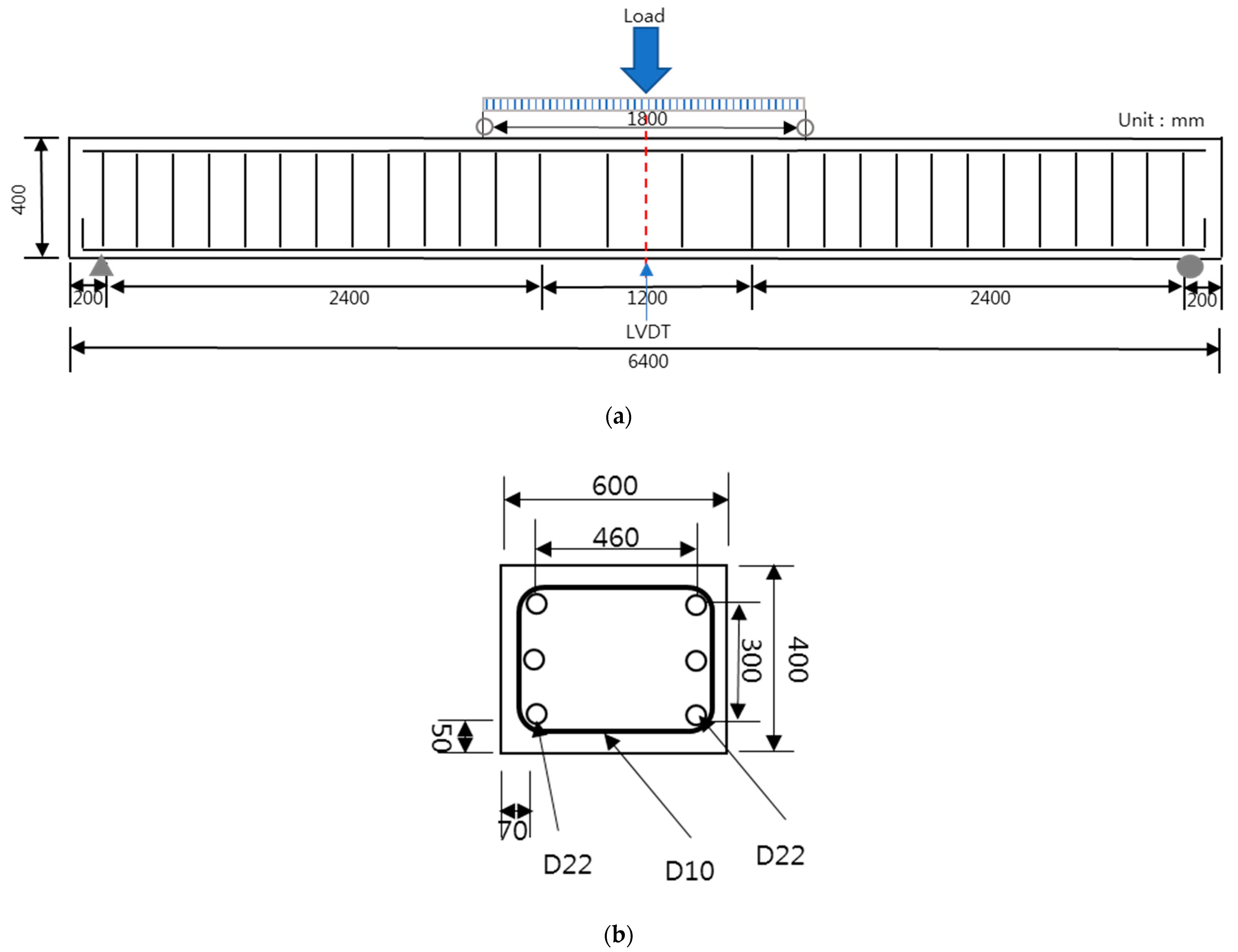
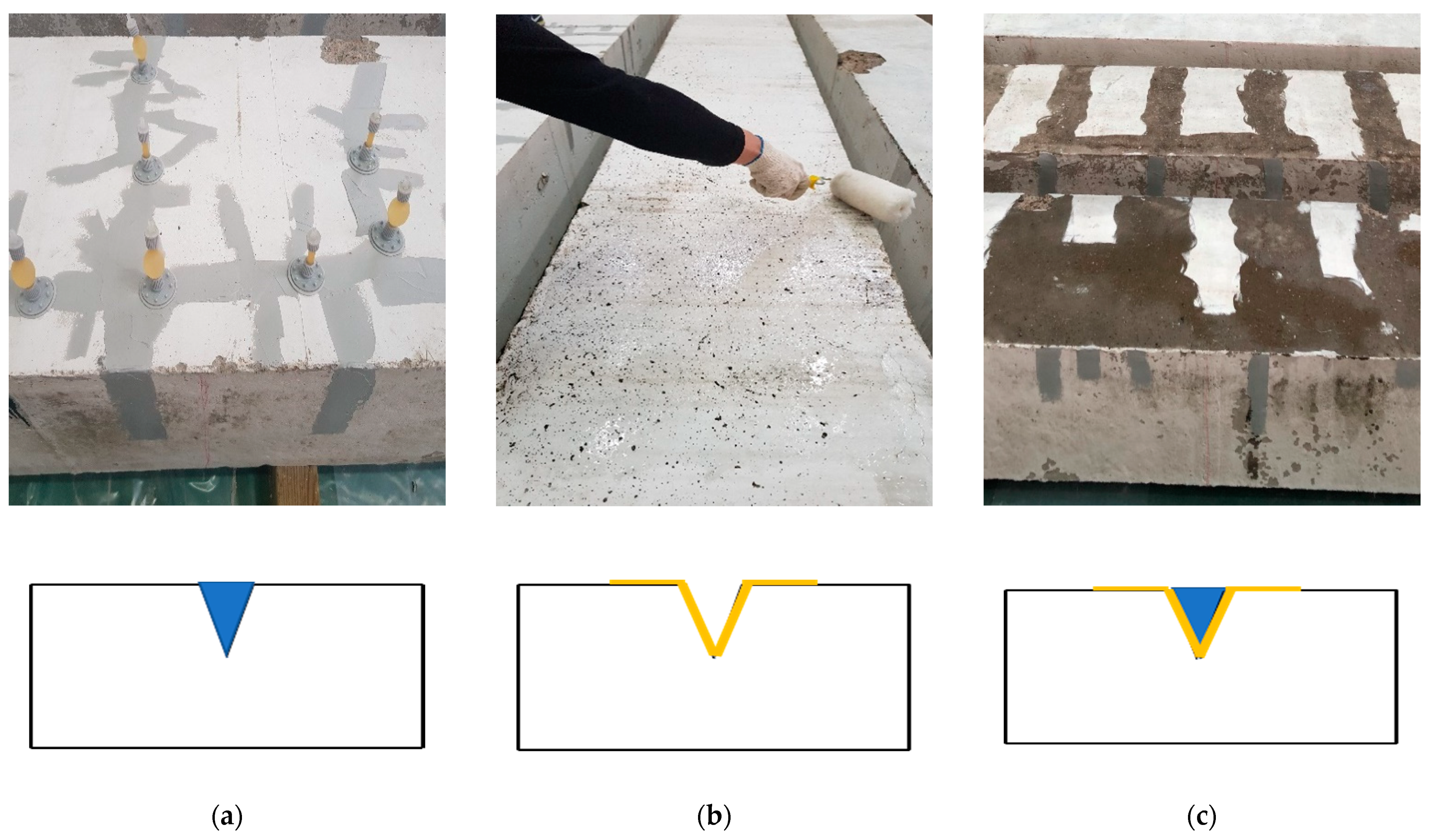
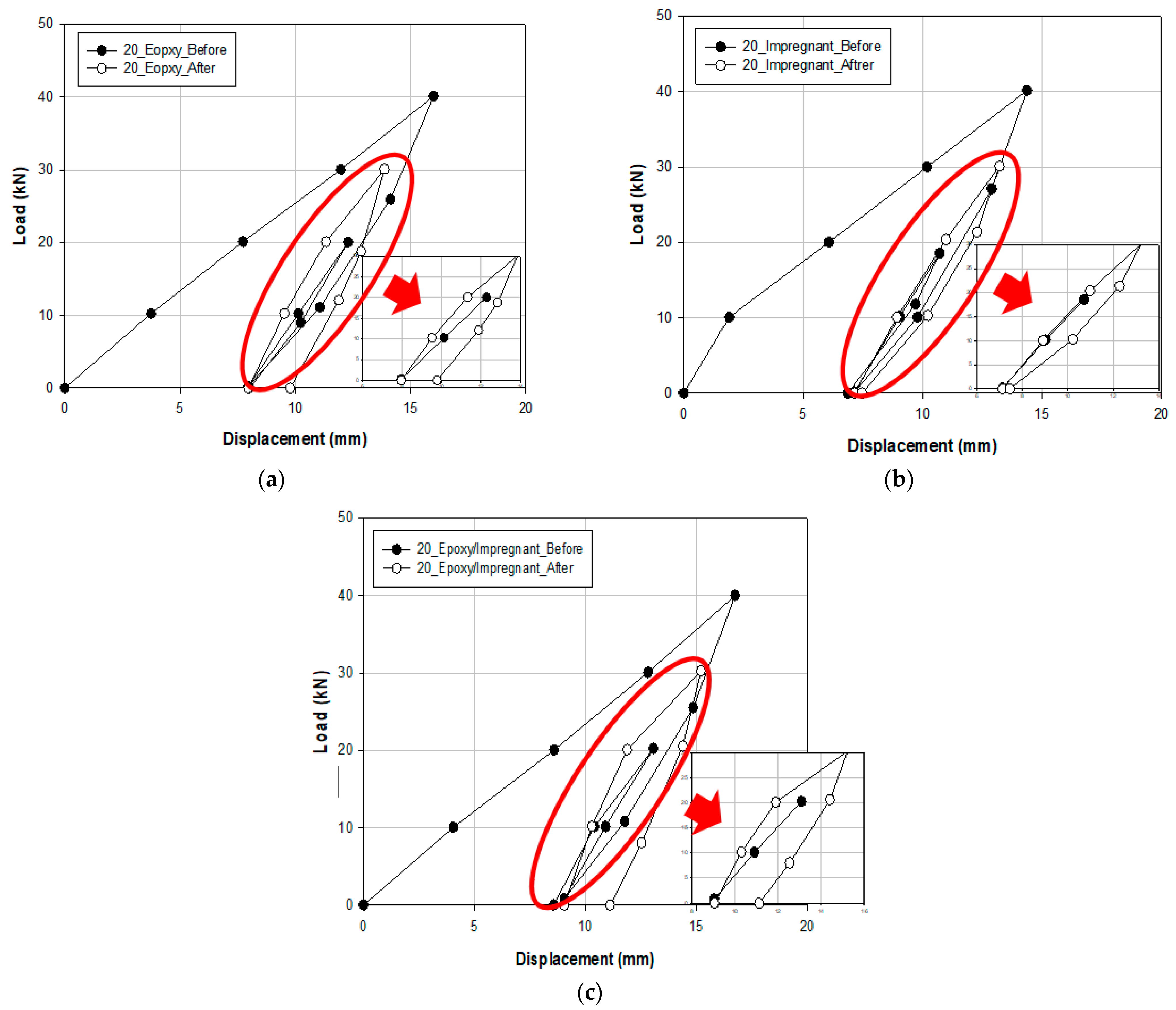
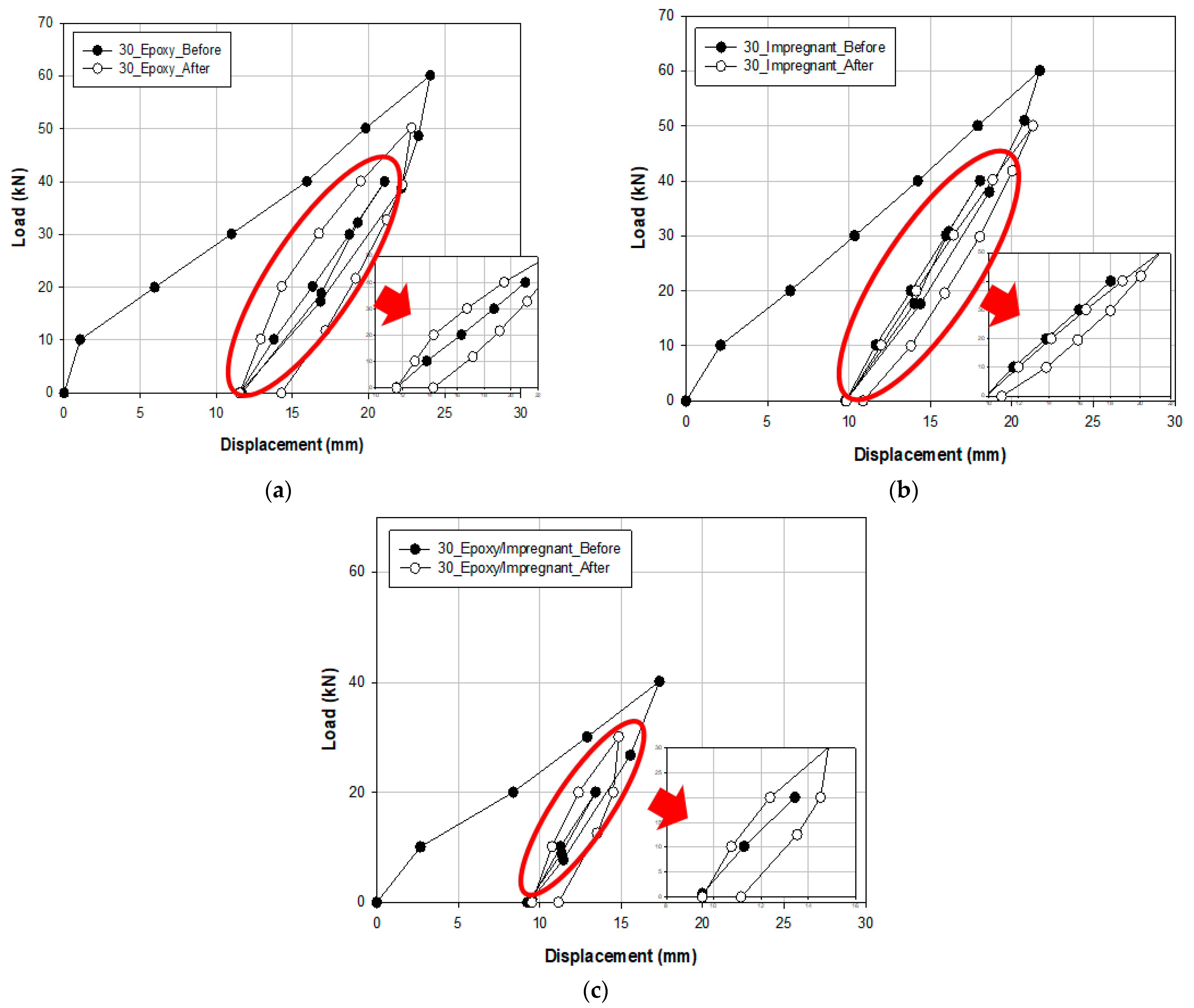
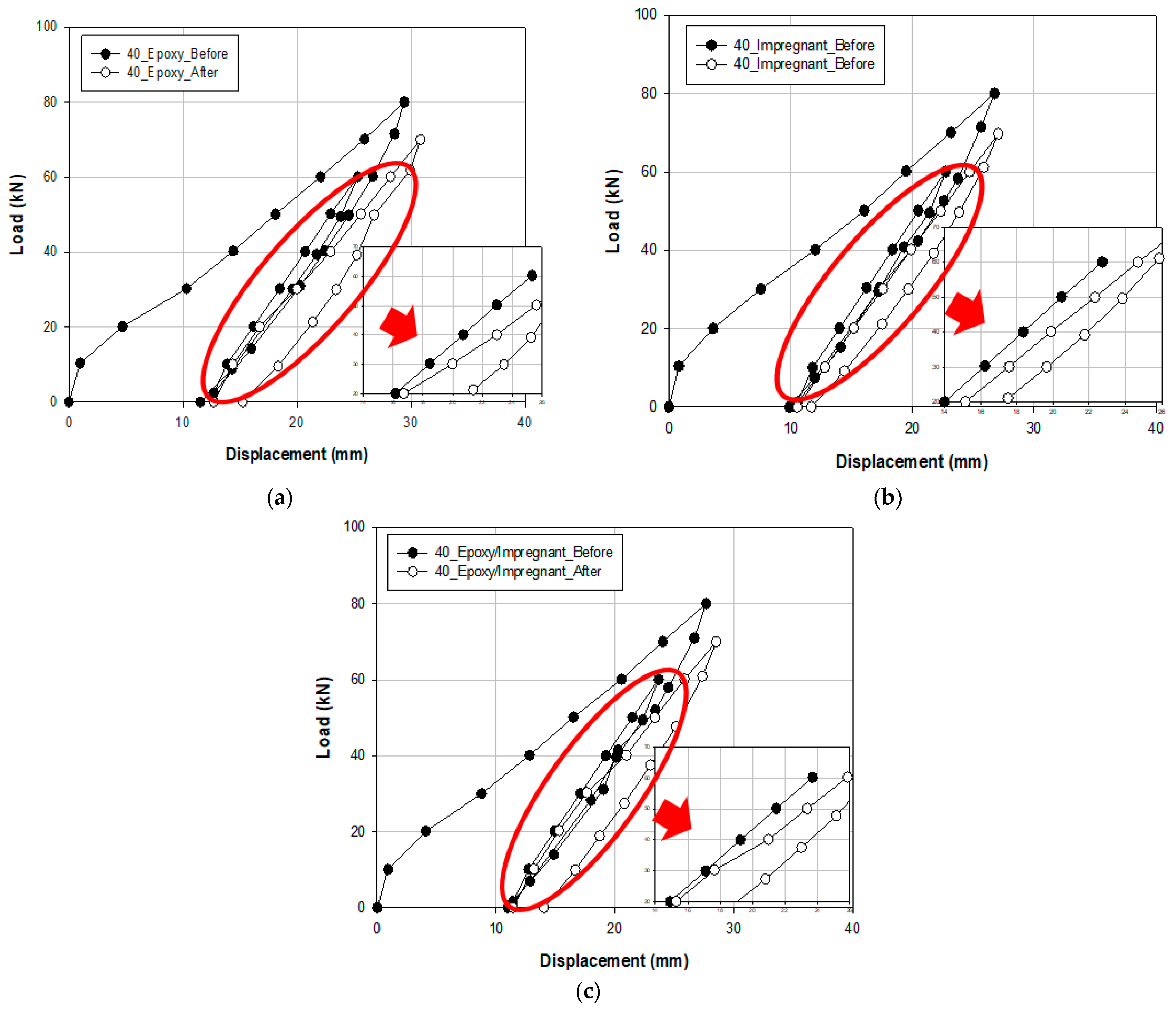
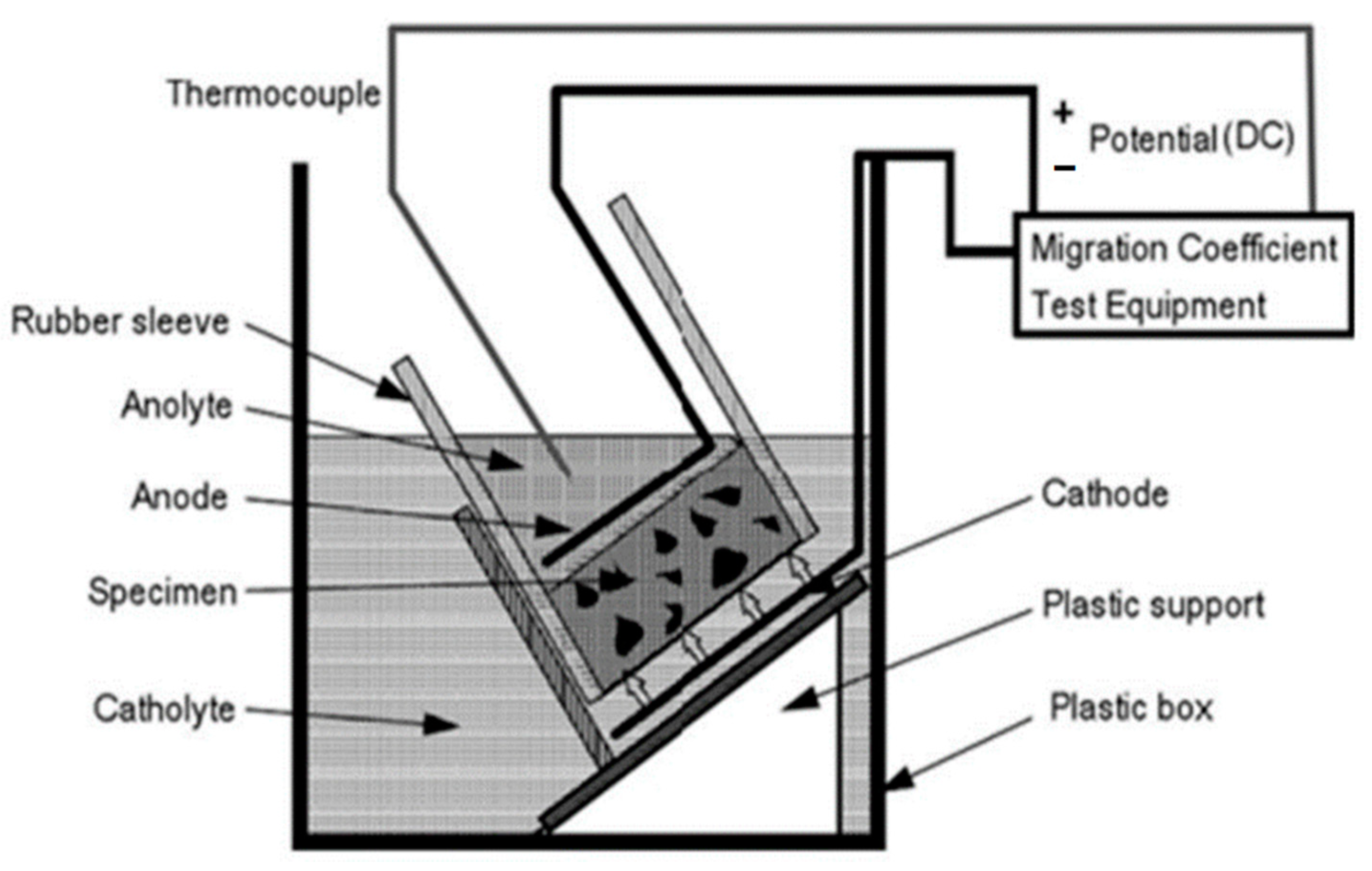
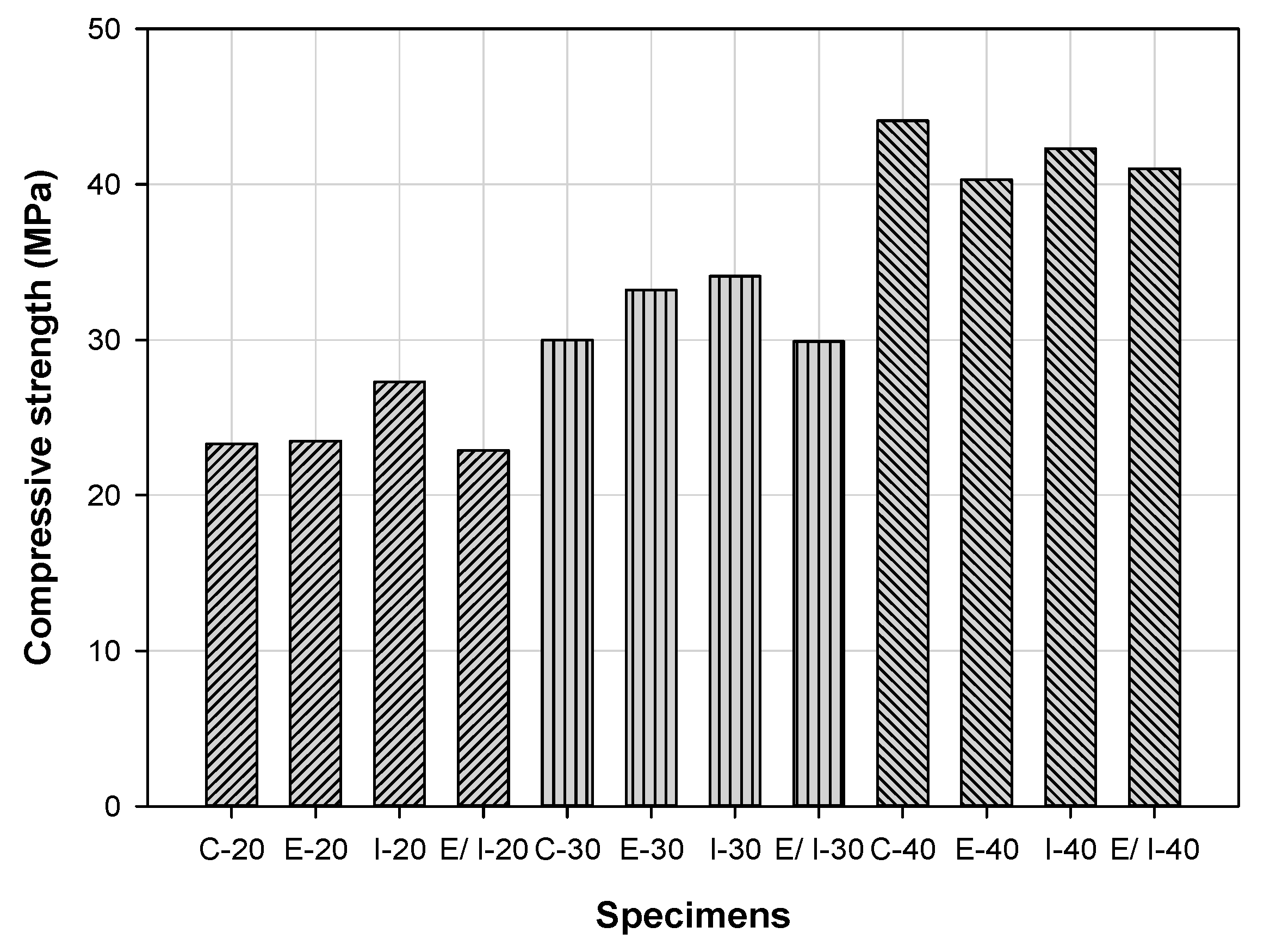

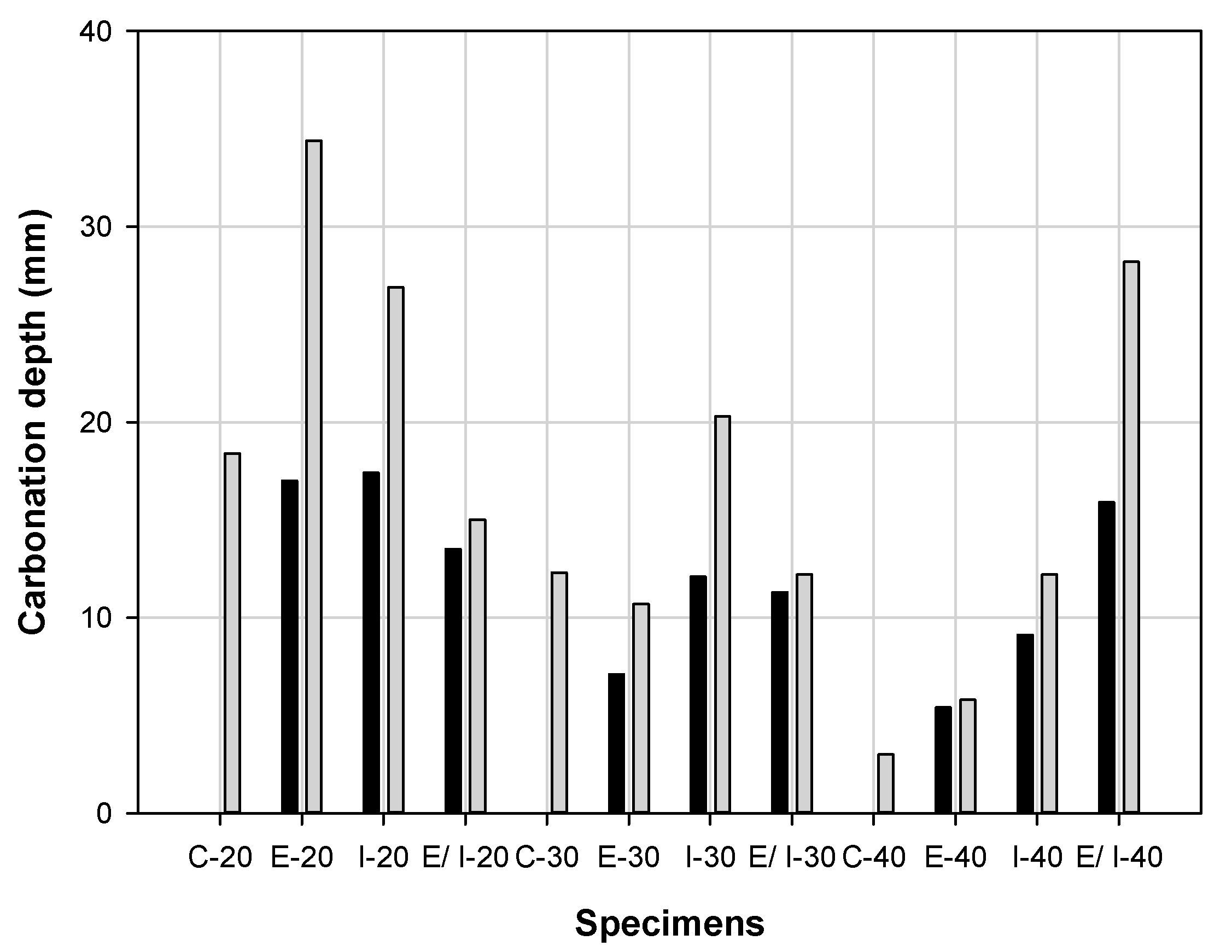
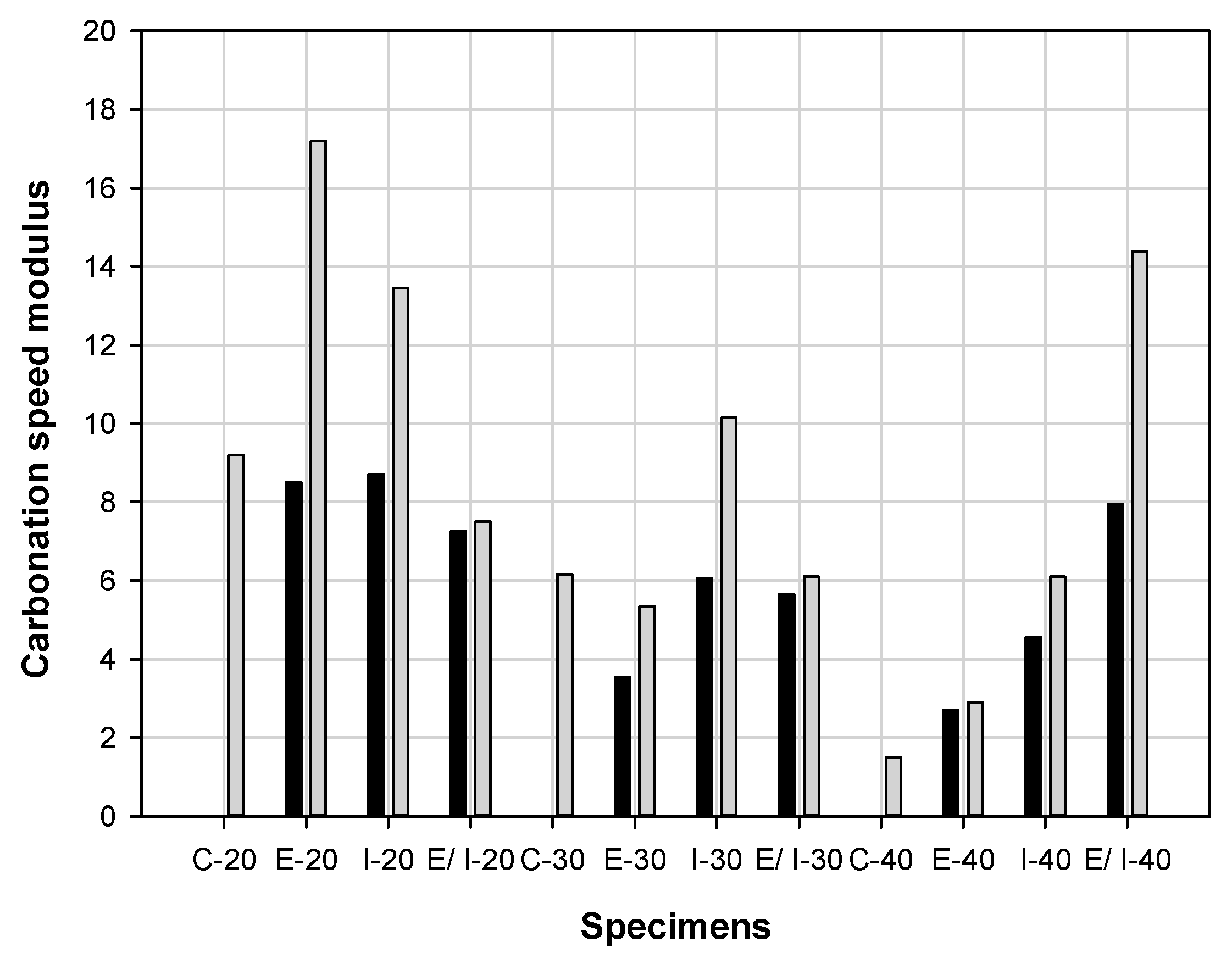


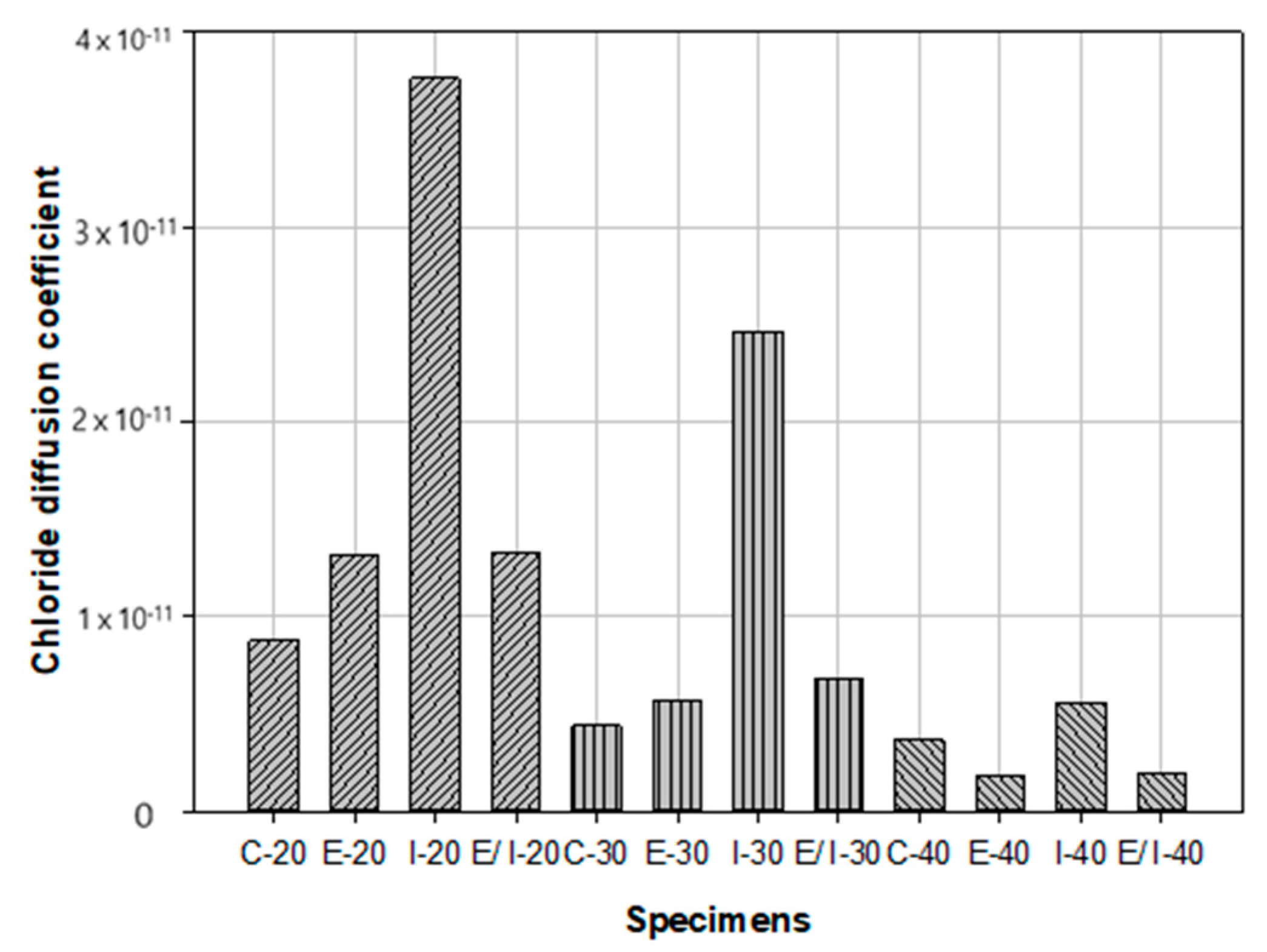
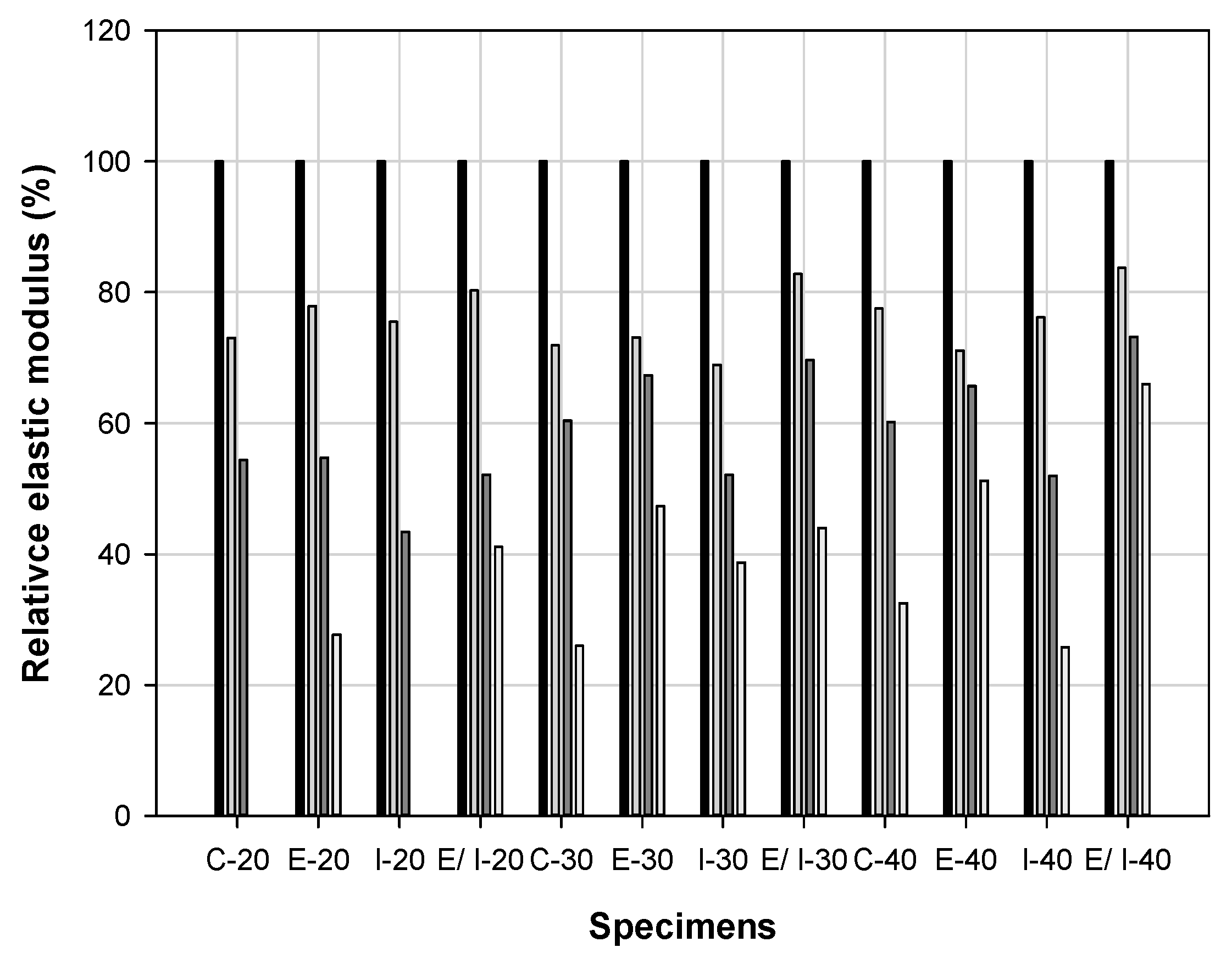
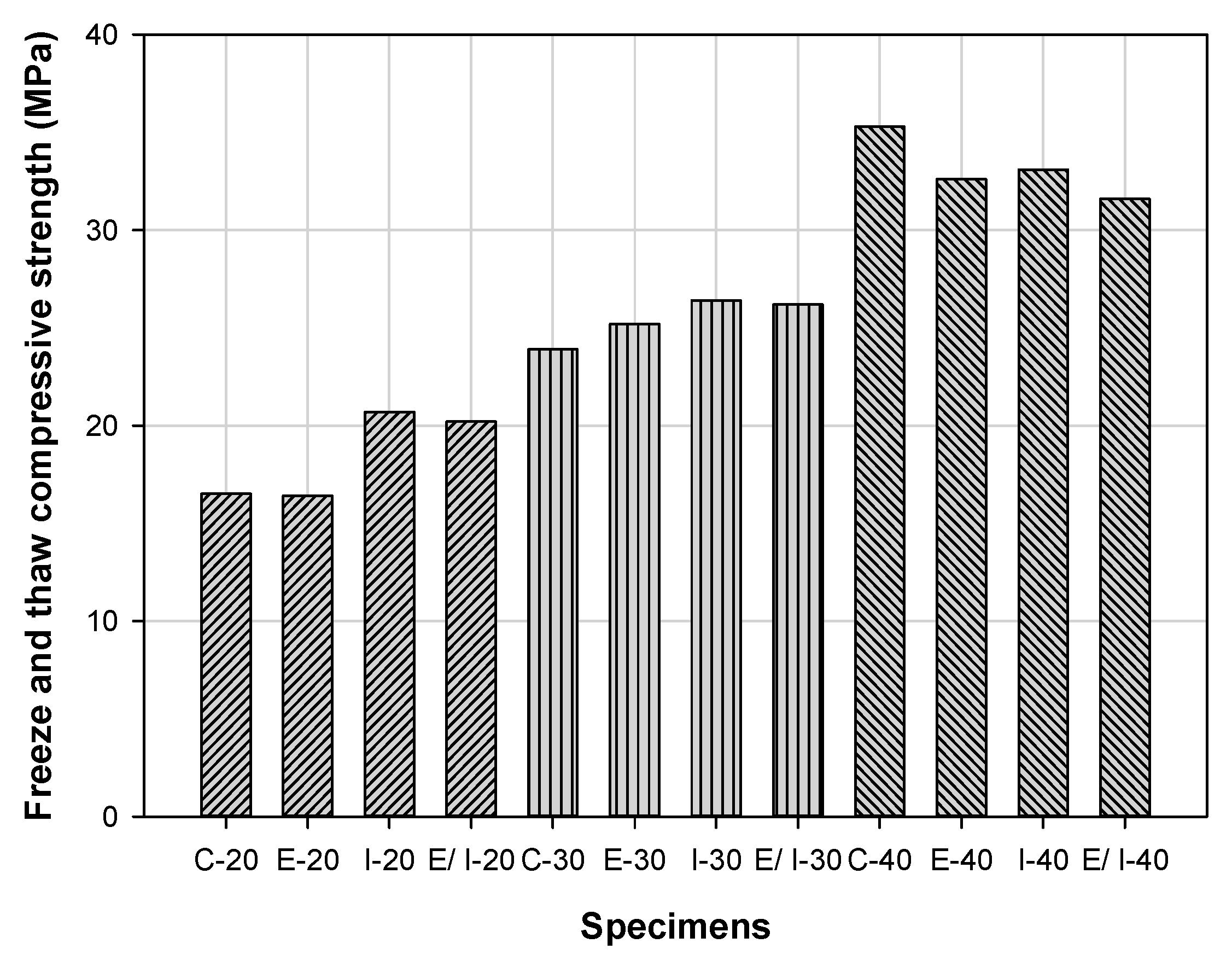
| Specimen | First Loading | Concrete Crack Repair and Curing | Second Loading |
|---|---|---|---|
| 20 MPa |
|
| Loading up to 30 kN |
| 30 MPa |
|
| Loading up to 50 kN |
| 40 MPa |
|
| Loading up to 70 kN |
| Specimen | Design Strength (MPa) | EA | Durability Test |
|---|---|---|---|
| Control | 20 | 3 | Compressive strength |
| 30 | 3 | ||
| 40 | 3 | ||
| Epoxy | 20 | 12 | Carbonation, chloride, freezing–thawing, compressive strength |
| 30 | 12 | ||
| 40 | 12 | ||
| Impregnating | 20 | 12 | |
| 30 | 12 | ||
| 40 | 12 | ||
| Epoxy/Impregnating | 20 | 12 | |
| 30 | 12 | ||
| 40 | 12 | ||
| Total | 117 | - | |
| Design Strength (MPa) | Repair Method | Compressive Strength (MPa) |
|---|---|---|
| 20 | Control | 23.3 |
| Epoxy | 23.5 | |
| Impregnating | 27.3 | |
| Epoxy/Impregnating | 22.9 | |
| 30 | Control | 30.0 |
| Epoxy | 33.2 | |
| Impregnating | 34.1 | |
| Epoxy/Impregnating | 29.9 | |
| 40 | Control | 44.1 |
| Epoxy | 40.3 | |
| Impregnating | 42.3 | |
| Epoxy/Impregnating | 41.0 |
| Design Strength (MPa) | Repair Method | Carbonation Depth (Noncrack) (mm) | Carbonation Depth (mm) | Carbonation Speed Modulus | ||
|---|---|---|---|---|---|---|
| 1 Week | 4 Weeks | 1 Week | 4 Weeks | |||
| 20 | Control | - | 18.4 | - | 9.2 | |
| Epoxy | 13.9 | 17.0 | 34.4 | 8.5 | 17.2 | |
| Impregnating | 15.1 | 17.4 | 26.9 | 8.7 | 13.45 | |
| Epoxy/Impregnating | 14.4 | 14.5 | 15.0 | 7.25 | 7.5 | |
| 30 | Control | - | 12.3 | 6.15 | ||
| Epoxy | 6.2 | 7.1 | 10.7 | 3.55 | 5.35 | |
| Impregnating | 5.8 | 12.1 | 20.3 | 6.05 | 10.15 | |
| Epoxy/Impregnating | 9.9 | 11.3 | 12.2 | 5.65 | 6.1 | |
| 40 | Control | - | 3.0 | 1.5 | ||
| Epoxy | 2.9 | 5.4 | 5.8 | 2.7 | 2.9 | |
| Impregnating | 4.5 | 9.1 | 12.2 | 4.55 | 6.1 | |
| Epoxy/Impregnating | 5.0 | 15.9 | 28.2 | 7.95 | 14.4 | |
| Design Strength (MPa) | Repair Method | Chloride Depth (mm) | Chloride Diffusion Coefficient (×10−12 m2/s) |
|---|---|---|---|
| 20 | Control | 9.4 | 8.76 × 10−12 |
| Epoxy | 14.2 | 1.31 × 10−11 | |
| Impregnating | 37.5 | 3.76 × 10−11 | |
| Epoxy/Impregnating | 14.4 | 1.33 × 10−11 | |
| 30 | Control | 5.1 | 4.38 × 10−12 |
| Epoxy | 6.8 | 5.71 × 10−12 | |
| Impregnating | 25.9 | 2.46 × 10−11 | |
| Epoxy/Impregnating | 7.9 | 6.84 × 10−12 | |
| 40 | Control | 4.4 | 3.65 × 10−12 |
| Epoxy | 2.5 | 1.87 × 10−12 | |
| Impregnating | 5.7 | 5.55 × 10−12 | |
| Epoxy/Impregnating | 2.7 | 1.94 × 10−12 |
| Design Strength (MPa) | Repair Method | Relative Elastic Modulus (%) | |||
|---|---|---|---|---|---|
| 0th Cycle | 100th Cycle | 200th Cycle | 300th Cycle | ||
| 20 | Control | 100 | 73.0 | 54.4 | - |
| Epoxy | 100 | 77.9 | 54.8 | 27.7 | |
| Impregnating | 100 | 75.5 | 43.4 | - | |
| Epoxy/Impregnating | 100 | 80.3 | 52.1 | 41.1 | |
| 30 | Control | 100 | 71.9 | 60.4 | 26.0 |
| Epoxy | 100 | 73.1 | 67.3 | 47.3 | |
| Impregnating | 100 | 68.9 | 52.1 | 38.7 | |
| Epoxy/Impregnating | 100 | 82.8 | 69.7 | 44.0 | |
| 40 | Control | 100 | 77.5 | 60.2 | 32.5 |
| Epoxy | 100 | 71.1 | 65.7 | 51.2 | |
| Impregnating | 100 | 76.2 | 51.9 | 25.8 | |
| Epoxy/Impregnating | 100 | 83.7 | 73.2 | 66.0 | |
| Design Strength (MPa) | Repair Method | Compressive Strength (MPa) |
|---|---|---|
| 20 | Control | 16.5 |
| Epoxy | 16.4 | |
| Impregnating | 20.7 | |
| Epoxy/Impregnating | 20.2 | |
| 30 | Control | 23.9 |
| Epoxy | 25.2 | |
| Impregnating | 26.4 | |
| Epoxy/Impregnating | 26.2 | |
| 40 | Control | 35.3 |
| Epoxy | 32.6 | |
| Impregnating | 33.1 | |
| Epoxy/Impregnating | 31.6 |
Publisher’s Note: MDPI stays neutral with regard to jurisdictional claims in published maps and institutional affiliations. |
© 2021 by the authors. Licensee MDPI, Basel, Switzerland. This article is an open access article distributed under the terms and conditions of the Creative Commons Attribution (CC BY) license (http://creativecommons.org/licenses/by/4.0/).
Share and Cite
Kim, T.-K.; Park, J.-S. Performance Evaluation of Concrete Structures Using Crack Repair Methods. Sustainability 2021, 13, 3217. https://doi.org/10.3390/su13063217
Kim T-K, Park J-S. Performance Evaluation of Concrete Structures Using Crack Repair Methods. Sustainability. 2021; 13(6):3217. https://doi.org/10.3390/su13063217
Chicago/Turabian StyleKim, Tae-Kyun, and Jong-Sup Park. 2021. "Performance Evaluation of Concrete Structures Using Crack Repair Methods" Sustainability 13, no. 6: 3217. https://doi.org/10.3390/su13063217
APA StyleKim, T.-K., & Park, J.-S. (2021). Performance Evaluation of Concrete Structures Using Crack Repair Methods. Sustainability, 13(6), 3217. https://doi.org/10.3390/su13063217






